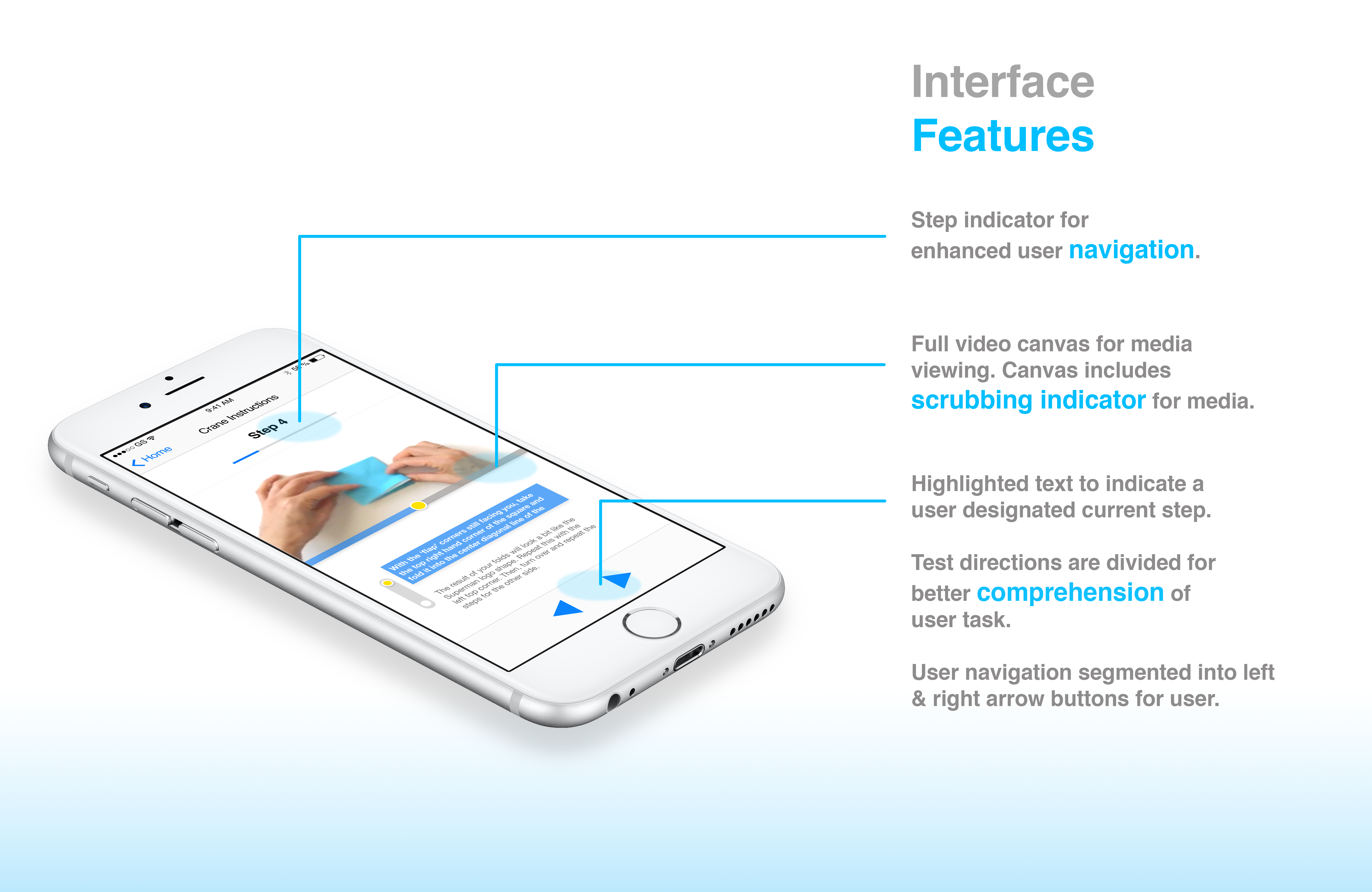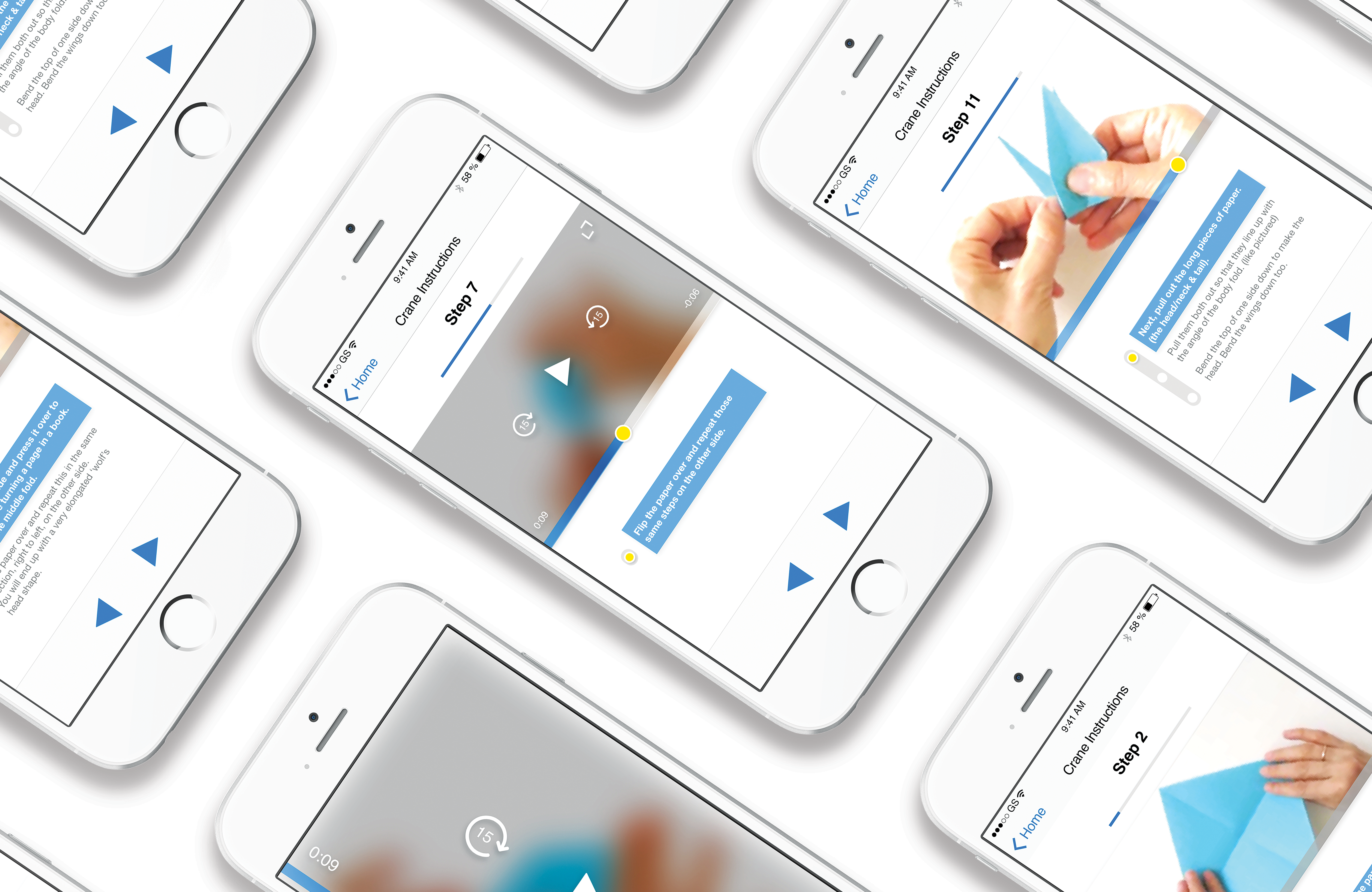The Human Centered Design Study is a study about how we learn. At the core of this production & research is the idea that users opinions, experiences, & data matter;
holistically to tailor a better design for the user.
I believe that people who use products should be given the chance
to know that they learn in their own unique ways. Those experiences are their own and should be dedicated to them, always...




Human Centered Design
The Human Centered Design: A User-Centric Approach to Designing Learning Models for Crafting Origami” is an undergraduate research project dedicated to understanding how to empathetically design a better app experience for teaching users how to fold origami.
Research Mentor
Interface Dimensions
iPhone 6 Display
4.7"
375px Width
1334 x 750 Display
Usability Case Study
To practice this empathetic system of design, a usability case-study was conducted that examines how a group of participants learn to craft origami, with the goal of translating those varied learning experiences into an empathetically user-centric and educational mobile application.
Based primarily on qualitative interviews and quantitative performance metrics, I conducted usability testing on a random sample of users with the assignment of seeing which medium of instruction users preferred to learn from when folding origami; testing consisted of instructional photos, video, and printed directions. From these observations, I designed a graphical mobile experience that accommodates for participants’ preferred learning methods.
Research Methods
Methods for user testing were grouped into two testing phases...
Phase One Testing
Phase One of testing was designed to understand what instructional model for learning origami was preferred amongst selected users.
User testing consisted of another instructional static based app, video, and printed directions.
Participants were tasked with folding the origami, based on the assigned medium of instruction. User metrics were recorded and documented; consisting of time and craft level.
Based on the gathered user feedback, we determined that the best medium of instruction to adapt to the design of our prototype application should be centered on a graphical video or animated instructions for learning to fold origami.
Download Phase 1 Study
Phase Two Testing
Phase Two of testing focused on understanding how users utilize and comprehend the application that was designed from user feedback received from Phase One of testing.
Methods for user testing consisted of observing users using the designed prototype application and recording their time and quality of craft.
Following user testing, users were then asked to fill out a System of Usability Scale questionnaire (SUS Questionnaire) and then prompted with a discussion interview of exit questions.
Quantitative data was calculated in the form of Time Based Efficiency models, Overall Relative Frequency, Effectiveness, Simplified Rate, and Completion Rate.
Research Findings
Research findings centered on how effectively and efficiently users were able to fold origami via the assigned methods of interaction and the adaptation of those instructional learning models into a better graphical mobile experience. Demonstrating how a focus in human centered design successfully allows designers to craft better experiences for the user.
Quantitative Results
Quantitative data was calculated in the form of Time Based Efficiency models, Overall Relative Frequency, Effectiveness, Simplified Rate, and Completion Rate and SUS Scoring.
We found that the time based efficiency of first time origami users was much higher (93%) than early folders time based efficiency (77%). First time users has accomplished their goal of folding origami with a score of 0.093 goals/minute, while early folders had a score fo 0.077 goals/minute.
Combined, our time based efficient model of user testing scored 86% and their goals were completed as 0.0866 goals/minute.
Qualitative Results
Based on qualitative feedback from exit interview questions, we found that users of the prototype application design did not read text based instructions and instead chose to focus on the animations of those instructions. If a user was stuck, they would prefer to rewatch the animation of the folding before having to read the instructions.
Download SUS Data
A majority of the tested users claim that they believe they could not have completed the folding of the origami without having some form of visuals or animations to guide them.
A majority of the users stated that they would prefer to have less words and better quality animations that did not go too fast. Users suggested that there should be more media controls integrated into the animation; features relating to video scrubbing and playback as well as audio instructions.
The craft of the origami cranes were “good”. Of the five participants, we felt that three of the designs best emulated the desired outcome of folding the origami, one participant’s design partially emulated the desired goal, and the final participant’s design did not at all.
Users also enjoyed the simplicity of the application and felt that the contrast of the colors and the background were a good choice.
EEG Brain Data
EEG headsets were worn by participants to better analyze and monitor their performance metrics. Subjects wore Emotiv Epoch and Emotiv Insight headsets. The headsets allowed us to better undersatnd what features worked better, and then refine those features.
EEG brain data that was pulled from users found that most users started off “engaged” and decreased in their “engagement” by the time that they completed their task.
A heat-map of each user was also recorded. Activity tracked each wavelength that was produced by the user's brains. Wavelengths monitored were: Delta, Theta, Alpha, and Beta.
Application Conclusion
Based off of our testing, we determined that the best adaptation of user learning models was the video medium. Users tended to use visuals and were often lost in the text. To accommodate, we designed the app around video, adding playback features, highlighting steps, and adding video scrubbing to the interface.
Overall, the design process, from conception, ideation, and execution, demonstrates how a focus in the application of an empathetic system of design can help us design a better experience for users of products.
Future Application
The future application of this study can be expanded on into educational media and explore how people, at the core, learn and visually process information with technology & varying devices.
There are so many wonderful things to learn about in this world & many more things we can do as designers and researchers to help those who want to understand and learn more about their world(s).
Undergraduate Research Profile
Access & view my Undergraduate Research Profile for this project and others from Cal Poly Pomona's RSCA Site.
Tools Used
Specific software tools and hardware used to achieve these results/methods were done with:
Emotiv Epoc
Emotiv Insight
Emotiv Pro Software
Adobe XD
Adobe Illustrator
Adobe Photoshop
Microsoft Excel
Specific Statistical Equations Used:
Time Based Efficiency Models
Overall Relative Efficiency
Effectiveness
Simplified Success Rate
Completion Rate
SUS Scoring Equation
Updated: May 2019